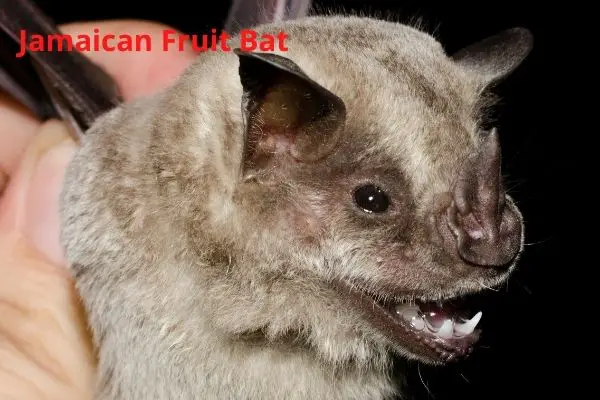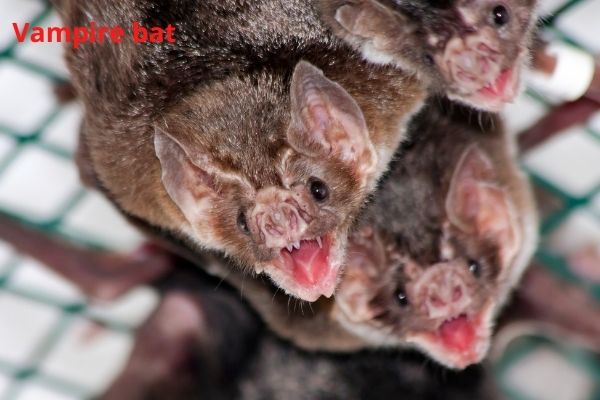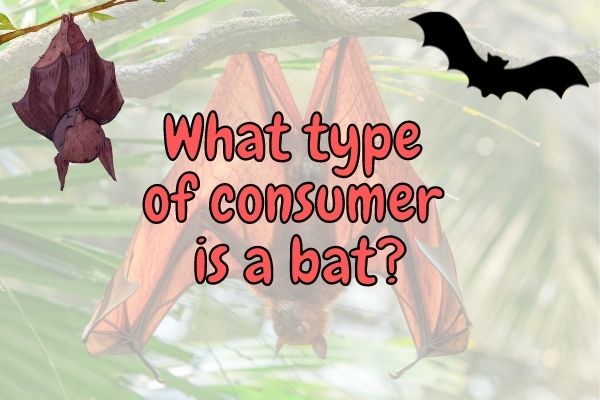Bats can be primary, secondary, and tertiary consumers since different bat species can eat insects, fruit, nectar, or blood.
Bats are flying mammals that are active at night. They are the only mammals capable of true, sustained flight.
There are over 1,200 species of bat, which is more than one-fifth of all mammal species in the world! They can be found on every continent except Antarctica and most islands.
Bats as a species are omnivores as they eat a variety of foods, including insects, fruit, nectar, pollen, and small animals. Bats eat insects, including moths, crickets, flies, beetles, and spiders. Bats also eat fruit such as figs, dates, and mangoes.
Bats can generally be divided into two groups based on their diet: insect-eating bats, which feed on insects, and fruit bats, which feed on fruit and nectar.
Bats play an important role in many ecosystems as the huge number of insects they consume each night helps to control insect populations.
This is especially important in agricultural areas, where bats can help to reduce the number of crop-damaging pests. In addition, bats also play a role in seed dispersal and pollination, which helps to ensure the health of plant populations.
Contents
Are Bats Carnivores, Herbivores or Omnivores?
Bats can be herbivores, insectivores, or carnivores. Most species are adapted to eating either fruit and nectar, or insects. Vampire bats are carnivores and feed on the blood of animals1. Other carnivorous bats feed on frogs and fish2.
Bats are a diverse group of mammals belonging to the order Chiroptera, and their dietary preferences vary significantly across species.
While the majority of bats are insectivores, there are several other feeding strategies observed among different bat species, including frugivory, nectarivory, carnivory, and omnivory. Therefore, it would be incorrect to categorize all bats under a single dietary classification.
Insectivorous bats, also known as microbats, make up the largest proportion of bat species. These bats primarily consume insects, such as moths, beetles, flies, and mosquitoes.
They have evolved specialized adaptations for hunting and consuming insects, including echolocation, which allows them to navigate and locate prey in complete darkness.
Examples of insectivorous bats include the little brown bat (Myotis lucifugus), the common pipistrelle (Pipistrellus pipistrellus), and the Mexican free-tailed bat (Tadarida brasiliensis).

Frugivorous bats, also known as fruit bats or flying foxes, have a diet primarily composed of fruits, nectar, and pollen. They play an essential role in pollination and seed dispersal for many plant species, making them vital for ecosystem health and biodiversity.
Fruit bats have specialized adaptations for feeding on fruits, including sharp teeth for piercing fruit skins and an elongated snout for accessing nectar.
Examples of frugivorous bats include the Indian flying fox (Pteropus giganteus), the Jamaican fruit bat (Artibeus jamaicensis), and the spectacled flying fox (Pteropus conspicillatus).

Nectarivorous bats have a specialized diet consisting mainly of nectar from flowers. They have long tongues and brush-like structures on their tongues and muzzles to extract nectar efficiently.
As they consume nectar, they inadvertently transfer pollen from one flower to another, aiding in the pollination process. The lesser long-nosed bat (Leptonycteris curasoae) and the Mexican long-tongued bat (Choeronycteris mexicana) are examples of nectarivorous bats.
Carnivorous bats have a diet primarily composed of other animals. These bats are relatively rare compared to other dietary groups and are typically found in specific habitats.
They consume a variety of prey, including small mammals, birds, reptiles, amphibians, and even other bats. One example of a carnivorous bat is the spectral bat (Vampyrum spectrum), which is known to prey on birds and other bats.
Omnivorous bats, as the name suggests, have a flexible diet and consume both plant and animal matter. They may eat fruits, insects, small vertebrates, and even carrion when available. The brown long-eared bat (Plecotus auritus) and the common vampire bat (Desmodus rotundus) are examples of omnivorous bats.
It’s important to note that while the dietary preferences mentioned here are general characteristics observed in various bat species, individual preferences and feeding strategies may vary within each species.
Bats exhibit remarkable diversity in their feeding habits, allowing them to occupy a wide range of ecological niches and contribute significantly to ecosystem functioning and balance.
Are Any Bats Omnivores?
Most bats are either insectivores or herbivores. Omnivores consume both plants and animals. Most bats stick to a diet of either only fruits, or only insects.
A few bats will consume both plants and animals.

The Jamaican fruit bat prefers to eat figs but will supplement its diet with insects when there is less fruit available3.
As seen in the photo of the Jamaican fruit bat above, its nose is large and the teeth are sharp. This indicates that it does also eat insects and that it hunts at night.
The oddly shaped nose of the Jamaican fruit bat is believed to be involved in emitting the sounds used in echolocation and is also seen in other bats that use echolocation to hunt for insects.
Are There Bats That Eat Only Plants?
Yes, there is! Fruit bats eat only plants. Fruit bats will eat fruit and nectar. Some fruit bats will eat any fruit or nectar they can find, whereas others are more specialized.
For example, the Mexican long-tongued bat eats mostly nectar and pollen. As its name suggests, it has a long tongue that can reach nectar deep inside flowers4.
Are There Bats That Eat Only Animals?
Yes, some bats eat only animals. Most insectivorous bats eat primarily insects. They can eat 500 to 3 000 insects in one night5.

Vampire bats feed exclusively on the blood of other animals1.
What Types of Bats are Predators?
Insectivorous and carnivorous bats are considered predators. Bats that eat insects include Vesper bats, bonneted bats, and leaf-nosed bats.
Other predatory bats from Central and South America, include fish-, and frog-eating bats 2, and the vampire bat, which feeds on the blood of other animals1.
One example of a predatory bat is the spectral bat (Vampyrum spectrum). This bat is known for its carnivorous diet and has been observed preying on birds, including small passerines.
With a wingspan of up to one meter, it possesses strong flight capabilities that enable it to pursue and capture its avian prey. The spectral bat is primarily found in Central and South America, inhabiting tropical rainforests.
Another example is the false vampire bats, also known as the Megadermatidae family. Within this family, there are several species, such as the ghost-faced bat (Mormoops megalophylla) and the greater false vampire bat (Megaderma lyra), which exhibit predatory behavior. These bats have strong jaws and teeth, allowing them to feed on a variety of prey, including other bats, small mammals, reptiles, and birds.
Certain insectivorous bats can also be considered predators due to their ability to capture and consume relatively large insects or other small animals. For instance, the bulldog bat (Noctilio leporinus) is known for its piscivorous feeding behavior.
It feeds on fish by skimming the water surface with its specialized elongated feet, capturing fish with its sharp claws and teeth. This bat is primarily found in the tropical regions of the Americas.
It’s important to note that while these bats are categorized as predators, their prey items can vary depending on their habitat, availability, and specific ecological niche. Bats have diversified feeding strategies, and while predatory behavior is less common overall, these examples demonstrate the adaptability and versatility of bats as hunters within their respective ecosystems.
Are Bats Producers, Consumers, or Decomposers?
Bats are consumers because they eat other living organisms. Producers gain their energy directly from the environment, for example from the sun, during photosynthesis.
Bats are primarily consumers in ecological terms. As mammals, bats obtain their energy and nutrients by consuming other organisms. However, it is important to note that the role of bats in ecosystems extends beyond simple consumer status, as they can indirectly contribute to nutrient cycling and ecosystem processes.
Bats are typically classified as secondary consumers because they predominantly feed on other organisms such as insects, fruits, nectar, or small vertebrates.
Insectivorous bats consume large quantities of insects, acting as natural pest controllers and helping to regulate insect populations. Frugivorous bats play a crucial role in seed dispersal and pollination, contributing to the reproduction and distribution of many plant species.
Nectarivorous bats facilitate pollination by transferring pollen from flower to flower as they feed on nectar. In these roles, bats serve as important links in food webs and contribute to energy transfer between trophic levels.
While bats are primarily consumers, their activities can indirectly contribute to the decomposition process in some cases.
For example, if a bat consumes an insect that has died or is decomposing, it aids in the breakdown of organic matter by transferring energy and nutrients to the next trophic level.
However, bats are not considered primary decomposers, as their role in decomposition is more incidental or indirect compared to organisms such as bacteria, fungi, and detritivores that actively break down organic matter.
It’s worth noting that certain bat guano (feces) can have fertilizer-like qualities due to its high nitrogen content, and it can contribute to nutrient enrichment in ecosystems where bats roost in large numbers. This can indirectly support the growth of certain decomposers and nutrient cycling processes.
In summary, bats are primarily consumers within ecosystems, occupying various trophic levels depending on their dietary preferences.
They play important roles as secondary consumers by controlling insect populations, facilitating pollination, and dispersing seeds. While bats may contribute to the decomposition process indirectly through their feeding activities, their main ecological role lies in energy transfer and nutrient cycling as consumers.
Only plants, algae, and some bacteria are producers. Since bats cannot photosynthesize, they are not producers.
What Type of Consumer is a Bat?
Fruitbats are primary consumers, since they only feed on plants. Insect-eating bats, on the other had, are secondary consumers, since they feed on insects, many of them who eat primarily plants.
Generally, herbivores are primary consumers, and omnivores and predators are secondary and tertiary consumers.
Vampire bats that feed on the blood of omnivores and carnivores may be considered tertiary or even quaternary consumers.
Can Bats be Considered Decomposers?
Bats are not decomposers, since they do not feed on dead or decaying matter. Insects that feed on feces, carcasses, or leaf litter are considered a type of decomposer called detritivores.
True decomposers are organisms that break down organic compounds into inorganic chemicals. Only certain bacteria and fungi have this ability.
Decomposers digest organic matter externally, by releasing enzymes and breaking down organic particles into inorganic chemical compounds such as water, carbon dioxide, nitrogen, phosphorus, calcium, and magnesium.
Why are Bats not Producers?
Bats are not producers because they cannot produce their own chemical energy. Bats need to eat other organisms to gain energy. Producers, like plants and algae, generate their own chemical energy from sunlight, through photosynthesis.
They use carbon dioxide, water and energy from the sun to make sugar. Other producers, like chemoautotrophic bacteria, can generate chemical energy by breaking down chemical compounds.
Sulfide-loving bacteria that live around hydrothermal vents in the deep sea, use hydrogen sulfide from the vent with oxygen from the water, to produce sugars.
Since the lack of sunlight means that photosynthesis is not possible, chemoautotrophic bacteria are the only producers in the food chain of the deep ocean and provide food for various consumers.
What Animals Prey on Bats?
Bats are eaten by birds of prey, skunks, raccoons, opossums, and humans.
Bats make up approximately 10% of all mammal prey of birds, and this percentage is rising.
Several animals prey on bats as part of their natural diet. While bats possess flight as an advantage, they are still vulnerable to predation, particularly during their foraging activities or while roosting. Some of the main predators of bats include:
- Birds of prey: Certain species of raptors, such as owls and hawks, are known to prey on bats. These birds have keen eyesight and are agile in flight, making them effective hunters of bats, especially during twilight or nighttime when bats are most active.
- Snakes: Some snake species are adept climbers and can access bat roosts, caves, or trees where bats congregate. These snakes, such as certain arboreal and cave-dwelling species, can ambush and capture bats as they enter or exit their roosts.
- Carnivorous mammals: Various carnivorous mammals may prey on bats opportunistically. For instance, larger mammals like carnivorous bats, mongooses, raccoons, weasels, and certain mustelids can target bats as part of their diet.
- Domestic and feral cats: Cats, both domestic and feral, are skilled predators and can pose a threat to bats, particularly when bats are roosting in buildings or trees within their hunting territories.
- Other bats: In some cases, larger predatory bat species, such as the spectral bat (Vampyrum spectrum), may prey on smaller bat species or even conspecifics.
- Humans: While humans are not natural predators of bats, some cultures or individuals may intentionally hunt bats for their meat or as part of traditional practices.
It’s important to note that predation on bats varies depending on the location, habitat, and specific bat species involved.
Some bat species have evolved roosting behaviors or adaptations that minimize the risk of predation, such as selecting well-protected roost sites, adopting cryptic coloration, or roosting in inaccessible locations.
Predation on bats is a natural ecological process, and it helps maintain population dynamics and ecological balance within ecosystems.
However, certain human activities, such as habitat destruction, disturbance of roost sites, or indiscriminate use of pesticides, can exacerbate the vulnerability of bats to predation and have negative impacts on their populations.
The most common predators of bats are owls, hawks, eagles and falcons. Bats are commonly hunted by humans in parts of Asia, Africa and Central America.
Conclusion
Bats play an important role in the ecosystem as insect population controllers, pollinators, and seed dispersers. They also form a big part of the diet of many birds of prey and other animals.
- Britannica. 2020. Vampire bat.
- Web Solutions. 2022. Bats: Diet. Science Encyclopedia
- Morrison P. 2011. Artibeus jamaicensis Jamaican fruit-eating bat. Animal Diversity Web.
- Bat Conservation International. 2022. Mexican long-tongued bat.
- Marcel Iseli. 2021. How many mosquitoes do bats eat? Animal food planet.




